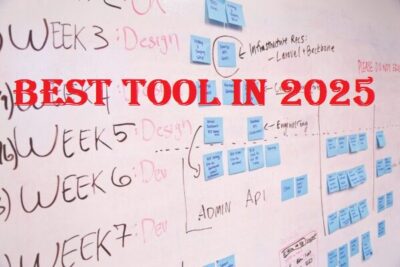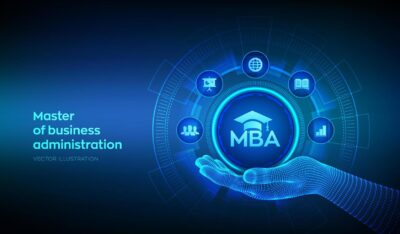The traditional map for career advancement is being redrawn. For generations, the path to leadership was a predictable, linear climb—a steady ascent within a single company or industry. But in today’s global economy, that map is obsolete. Careers are now dynamic, multi-faceted journeys that demand constant adaptation, strategic pivots, and the continuous acquisition of new skills. For professionals like Adnan, a talented engineer feeling capped in a technical role, or Fatima, a project manager seeking to transition from execution to strategic leadership, the question is no longer just “what’s next?” but “how do I build a future-proof career?” This guide is built on the premise that a Master of Business Administration is not merely a degree; it is a powerful tool for strategic reinvention. Specifically, the rise of the best online MBA programs has created an unprecedented opportunity for ambitious professionals worldwide to acquire elite business acumen, build a global network, and pivot their careers without putting their lives on hold. This course is your new map. It is an exhaustive, practical guide designed to navigate the complex world of online business education, empowering you to make the most strategic investment in your future.
Disclaimer: This course is designed for a global audience and does not focus on the requirements, regulations, or practices of any specific country or region. While examples may reference international standards and institutions, participants should always verify local accreditation, admission criteria, and policies that apply to their own location.
Table of contents
- 1. A Comprehensive Introduction to the World of Best Online MBA Programs
- 1.1 What Exactly Is an Online MBA and Why Does It Matter in the Global Marketplace?
- 1.2 The Evolution of Online Business Education: From Correspondence to a Digital Revolution
- 1.3 How Do You Choose: A Practical Comparison of Online vs. On-Campus MBA Programs
- 1.4 Decoding the Search: What Are Today’s Professionals Looking for in the Best Online MBA Programs?
- 2. How to Navigate Accreditation and Global Rankings for the Best Online MBA Programs
- 2.1 Understanding the Gold Standard: A Guide to AACSB, EQUIS, and AMBA
- 2.2 What Do Global Rankings Really Measure? Deconstructing the Financial Times, QS, and U.S. News Methodologies
- 2.3 How to Read Between the Lines of Ranking Tables and Data Points
- 2.4 How Accreditation Directly Impacts Your Degree’s Global Value and Your Career
- 3. How to Select the Optimal Specialization in the Best Online MBA Programs
- 3.1 A Global Tour of High-Impact MBA Specializations: Finance, Marketing, Technology, and Beyond
- 3.2 Analyzing the 2025 Job Market: Which Specializations Offer the Greatest Opportunities?
- 3.3 A Practical Toolkit for Comparing and Contrasting Program Curricula
- 3.4 How to Align Your Specialization Choice with Your Personal and Professional Blueprint
- 4. Mastering the Application: Your Strategy for Acceptance
- 4.1 How to Build a Compelling Application Portfolio: CV, Transcripts, and Experience
- 4.2 Writing a Statement of Purpose That Tells Your Unique Story
- 4.3 A Strategic Guide to Language and Aptitude Examinations (TOEFL, IELTS, GMAT, GRE)
- 4.4 How to Prepare for and Excel in the Admissions Interview: A Simulation Guide
- 5. A Guide to Funding Your Degree Without Debt
- 5.1 Unlocking Financial Support: A Global Guide to Merit-Based and Need-Based Scholarships
- 5.2 How to Craft a Winning Scholarship Application and Secure Grants
- 5.3 How to Build a Case for Employer Sponsorship and Tuition Support
- 5.4 Creative Strategies for Reducing Costs and Maximizing Your Financial Return
- 6. How to Achieve Maximum Career Return from the Best Online MBA Programs
- 6.1 How to Architect Your Post-Graduation Career Path: Short- and Long-Term Planning
- 6.2 Building Your Lifelong Professional Development Plan
- 6.3 Beyond Salary: How to Measure the True Value of Your Degree with Performance Indicators
- 6.4 Global Success Blueprints: Inspiring Journeys Across Different Sectors
- 7. Excelling in Your Studies: Best Practices for Learning, Engagement, and Networking
1. A Comprehensive Introduction to the World of Best Online MBA Programs
To make an informed decision, you must first understand the landscape. This initial module provides a foundational understanding of the online MBA, tracing its transformation from a niche educational product into a dominant force in global business education. We will explore its core definition and importance, chart its remarkable evolution, conduct a practical comparison with its on-campus counterpart, and analyze the key trends shaping what today’s professionals are searching for. This module establishes the context for your entire journey, ensuring you begin with a clear and comprehensive view of the opportunities that lie ahead.
1.1 What Exactly Is an Online MBA and Why Does It Matter in the Global Marketplace?
An online Master of Business Administration (MBA) is a postgraduate degree program designed to develop the skills required for careers in business and management. Its core purpose is to equip students with a mastery of business management principles and leadership qualities, while also providing a specific understanding of various business fields, including finance, marketing, human resource management, and data analytics. The fundamental distinction of an online MBA is its delivery format; all coursework, from lectures and assignments to communication with instructors and peers, is conducted through digital platforms. This format allows professionals to pursue advanced education without the need to relocate or pause their careers, a significant advantage in a fast-paced global market.
The importance of the online MBA in today’s marketplace is multifaceted and growing. Firstly, it offers unparalleled flexibility, allowing working professionals, business owners, and new entrants to the job market to balance their studies with professional and personal commitments. Secondly, it is often more
cost-effective than its on-campus equivalent, as it eliminates expenses related to relocation, accommodation, and daily commuting. This increased accessibility democratizes advanced business education, opening doors to a wider and more diverse pool of global talent.
Furthermore, employers increasingly recognize the value of online MBA degrees from reputable institutions. They value the specific skills graduates bring, such as enhanced time management, self-discipline, and digital fluency—competencies honed by the very nature of the online learning environment. Many online programs boast highly diverse, international cohorts, immersing students in a range of business cultures and perspectives from Europe to Asia to the Americas. This exposure is critical for developing a truly global mindset, preparing graduates to lead multicultural teams, navigate different work habits, and manage cross-border business operations effectively. Consequently, an online MBA is more than a credential; it is a strategic tool for career advancement, offering a pathway to international opportunities and significant earning potential.
1.2 The Evolution of Online Business Education: From Correspondence to a Digital Revolution
The journey of the MBA began over a century ago, with the world’s first program established at Harvard Business School in 1908 in response to the Industrial Revolution’s demand for trained business leaders. For most of the 20th century, the MBA remained a traditional, campus-based two-year program. However, the seeds of distance learning were sown long before the digital age, with the first online MBA programs emerging in the late
1980s, even before the internet as we know it was in public use. These early iterations were basic, often relying on simple video lectures and email correspondence, a far cry from the sophisticated platforms of today.
The true revolution in online business education began with advancements in technology. The past decade, and particularly the period after 2018, witnessed an explosion in the number of programs. In just five years, the number of online MBA offerings surged by nearly a third, from 555 in 2018 to 732 by 2023. This growth was dramatically accelerated by the global events of
2020, which forced a worldwide shift to remote work and learning. That year marked a historic turning point: for the first time, students enrolled in online MBA programs outnumbered those in on-campus programs. By the fall of
2023, a decisive 58% of all enrolled MBA students were studying online, cementing its position as the preferred format for the modern professional.
This digital revolution has transformed the online MBA from a peripheral option into a mainstream powerhouse. Today’s programs are no longer just about remote access; they are sophisticated learning ecosystems featuring interactive case studies, real-time collaboration tools, AI-driven personalized learning paths, and even virtual reality simulations. This evolution reflects a broader trend in higher education towards more flexible, accessible, and technologically integrated learning models, ensuring that the online MBA is not just an alternative to the on-campus experience, but in many ways, a forward-looking evolution of it.
1.3 How Do You Choose: A Practical Comparison of Online vs. On-Campus MBA Programs
Choosing between an online and an on-campus MBA is a critical decision that hinges on your personal learning style, career situation, and life commitments. To make the right choice, you must conduct a practical, head-to-head comparison of what each format offers. The best online MBA programs are designed for maximum flexibility, making them ideal for professionals who cannot afford a career break or have significant family or work obligations. You can study from anywhere in the world, fitting coursework around your existing schedule, and you save substantially on costs associated with relocation and commuting. However, this format demands a high degree of self-motivation and discipline, as the structured environment of a physical campus is absent. While networking opportunities exist, they are primarily virtual and may not foster the same depth of connection as face-to-face interactions.
On the other hand, an on-campus MBA provides a structured, immersive experience. It is well-suited for learners who thrive on in-person discussions, direct mentorship from professors, and spontaneous collaboration with peers. On-campus students have unfettered access to physical resources like libraries, career centers, and extracurricular clubs, which can enrich the educational journey. The primary drawbacks are the high cost, which includes not only tuition but also significant living expenses, and the necessity of taking a one- to two-year break from your career, which represents a substantial opportunity cost.
Ultimately, the decision is a strategic trade-off. If your priority is flexibility, cost-effectiveness, and the ability to apply learnings to your job in real-time, an online MBA is likely the superior choice. If you value an immersive, structured environment and believe the benefits of in-person networking and campus life outweigh the high cost and career interruption, a traditional program may be a better fit.
| Feature | Online MBA | On-Campus MBA |
| Flexibility & Schedule | High. Study from anywhere, often at your own pace (asynchronous). Ideal for balancing work and family commitments. | Low. Requires physical presence for scheduled classes. Less suitable for those who cannot relocate or pause their careers. |
| Program Cost | Lower. Tuition can range from $20,000 to over $100,000, but eliminates costs for relocation, housing, and commuting. | Higher. Tuition ranges from $30,000 to over $120,000, plus substantial costs for room, board, and campus fees. |
| Networking Opportunities | Primarily virtual. Involves online forums, group projects, and virtual events. May require more proactive effort to build deep connections. | Robust and in-person. Extensive opportunities through classes, clubs, events, and informal interactions. Fosters stronger, more organic connections. |
| Learning Environment | Requires high self-discipline and motivation. Communication is mostly written. Relies on technology like learning management systems. | Structured and immersive. Benefits from face-to-face discussions, direct access to faculty, and collaborative group work in a shared physical space. |
| Access to Resources | Access to digital libraries and online career services. Misses out on physical campus facilities like labs, athletic centers, and in-person events. | Full access to all campus facilities, including libraries, career centers, gyms, labs, and a vibrant calendar of on-campus lectures and activities. |
| Career Impact | Allows immediate application of learning to your current job. Avoids a career gap. Degree from a reputable school is highly recognized. | Often requires a career break. Provides dedicated, on-site career support and recruiting events. Strong brand value from prestigious schools. |
1.4 Decoding the Search: What Are Today’s Professionals Looking for in the Best Online MBA Programs?
The landscape of what applicants seek in the best online MBA programs is undergoing a significant transformation, driven by shifts in the global economy and evolving career expectations for 2025. One of the most profound trends is a pivot away from a singular focus on institutional prestige. Today’s candidates are increasingly pragmatic, prioritizing a clear and quantifiable Return on Investment (ROI) over traditional rankings. They are asking critical questions about tangible career outcomes: Will this degree lead to a promotion, a higher salary, and the specific skills I need to advance? This ROI-centric mindset has made employment rates and post-MBA salary growth key metrics for program evaluation.
Another dominant trend is the demand for future-focused curricula. Coursework in Artificial Intelligence (AI), data analytics, and Environmental, Social, and Governance (ESG) principles is no longer a niche interest but a core requirement for many applicants. Professionals recognize that proficiency in these areas is essential for leadership in the modern business world. This is reflected in popular search queries, where terms like
“operations management,” “strategic management,” and specialized degrees such as “mba in hr” or “mba in healthcare management” show high search volumes, indicating a demand for practical, job-relevant specializations.
Interestingly, while online learning offers unprecedented flexibility, there is also a renewed appreciation for in-person connection. A 2025 survey revealed that 73% of prospective students now prefer full-time, on-campus learning, a significant jump from the pandemic era. This suggests that while the convenience of online is valued, the immersive experience and networking opportunities of a traditional program still hold strong appeal for certain demographics. The
best online MBA programs are responding to this by integrating hybrid models and in-person residencies, offering a “best of both worlds” approach that combines digital flexibility with invaluable face-to-face interaction. This complex interplay of ROI focus, demand for cutting-edge skills, and a desire for community is defining the future of business education.
2. How to Navigate Accreditation and Global Rankings for the Best Online MBA Programs
Understanding accreditation and rankings is not about chasing logos or numbers; it is about developing a critical framework to assess quality and ensure your educational investment aligns with your global career ambitions. This module demystifies these complex systems. You will learn to distinguish between the world’s leading accreditation bodies, deconstruct the methodologies of major ranking publications, and, most importantly, learn how to read between the lines to find the data that truly matters for your future. This is your guide to making a data-informed, strategic choice.
2.1 Understanding the Gold Standard: A Guide to AACSB, EQUIS, and AMBA
Navigating the world of business school accreditation can feel like deciphering an alphabet soup of acronyms. However, understanding the “Triple Crown”—AACSB, EQUIS, and AMBA—is the first step in quality assurance. These are not just badges; they are rigorous, internationally recognized endorsements of a school’s quality, and holding one or more is a significant differentiator.
AACSB (The Association to Advance Collegiate Schools of Business) is widely considered the most prestigious and longest-standing form of specialized accreditation a business school can earn. Established in
1916, this U.S.-based body accredits less than 6% of the world’s business schools, signifying a high standard of excellence. The AACSB accreditation process is a voluntary, multi-year journey that involves a thorough peer review of a school’s mission, faculty qualifications, curriculum, and overall operations. For students, an AACSB-accredited degree signals that the program meets rigorous standards for academic quality and continuous improvement, a mark of distinction that is highly valued by global employers, many of whom preferentially hire graduates from these institutions.
EQUIS (EFMD Quality Improvement System), established by the European Foundation for Management Development (EFMD), offers a different but equally rigorous perspective. Unlike accreditations that may focus on specific programs, EQUIS evaluates the entire business school as a whole. Its key distinction is a strong emphasis on
internationalization, corporate connections, ethics, and sustainability. An EQUIS accreditation signals that a school has a clear global strategy, deep ties with the business community, and a commitment to producing globally responsible leaders. This makes it a particularly valuable indicator for applicants seeking a career in a multinational corporation or a role with a strong international dimension.
AMBA (The Association of MBAs) is unique among the top three because it specifically accredits a school’s portfolio of postgraduate management programs—namely the MBA, Doctor of Business Administration (DBA), and Master in Business and Management (MBM). This UK-based body has a sharp focus on the practical quality of the MBA experience itself. Its criteria are holistic and stringent, assessing everything from the institution’s strategic mission to the caliber of its student intake, faculty credibility (requiring that at least
75% of teaching staff hold a relevant postgraduate degree), curriculum depth, and student interaction. For a student focused purely on the quality and integrity of the MBA program itself, AMBA accreditation is a powerful and direct benchmark of excellence.
A school holding all three accreditations—the “Triple Crown”—is part of an elite group, signaling a comprehensive, globally-oriented, and high-quality business education.
| Feature | AACSB | EQUIS | AMBA |
| Primary Focus | Overall business school quality with a strong emphasis on academic research and faculty qualifications. | Comprehensive quality review of the entire institution, not just specific programs. | Specific portfolio of postgraduate management programs (MBA, DBA, MBM). |
| Geographic Origin | United States. | Europe. | United Kingdom. |
| Key Emphasis | Research output, strategic planning, curriculum innovation, and continuous improvement. | Internationalization, corporate connections, ethics, responsibility, and sustainability. | Student cohort quality (work experience), faculty credibility, curriculum design, and overall MBA experience. |
| Who is Accredited? | The business school as a whole, covering all its degree offerings, including online programs. | The entire business school, assessing its overall strategy and market positioning. | Only the specific MBA, MBM, and DBA programs within a business school. |
| Typical Applicant Benefit | Signals a degree with high academic rigor, valued by research-oriented institutions and top global corporations. | Indicates a school with strong global exposure and deep corporate ties, ideal for international careers. | Guarantees the quality of the MBA program itself, ensuring a high-caliber peer group and a relevant, well-designed curriculum. |
2.2 What Do Global Rankings Really Measure? Deconstructing the Financial Times, QS, and U.S. News Methodologies
Global rankings are one of the most visible tools for comparing the best online MBA programs, but they are not monolithic. Each major publication uses a distinct methodology, weighing different factors and thus telling a different story about what “best” means. Understanding these methodologies is crucial to using rankings as an effective decision-making tool rather than a misleading headline.
The Financial Times (FT) Online MBA Ranking is heavily weighted towards alumni success. A substantial 60% of a school’s final score is derived from alumni surveys measuring outcomes like current salary and salary increase (each accounting for 12% of the total score), career progress, and value for money. Another
30% is based on school-provided data, with a strong focus on diversity metrics (gender and international representation among students, faculty, and board members). The final 10% is a research rank based on faculty publications. The FT also incorporates modern criteria such as a school’s carbon footprint and the integration of
ESG topics into the curriculum, making it a strong choice for those prioritizing career outcomes and sustainability.
The QS Online MBA Rankings employ a different framework built on four “lenses.” The heaviest weight, 35%, is given to Faculty and Teaching, which includes academic reputation surveys and the student completion rate. The second lens,
Employability, accounts for 30% and is based entirely on the results of the QS Employer Reputation survey, making it a powerful indicator of how recruiters perceive a school’s graduates.
Class Profile also holds a 30% weight, assessing metrics like the number of nationalities represented, the percentage of women, and the average work experience of the cohort. A final, smaller 5% is allocated to Class Experience, which evaluates the technological platform and level of interaction.
In contrast, the U.S. News & World Report Best Online MBA Rankings focus exclusively on programs within the United States and rely on a methodology that does not survey students or employers. Instead, it is based on data submitted directly by the schools and a peer assessment survey of academic officials. Its formula is broken down into five weighted categories:
Student Engagement (30%), which measures factors like graduation rates and student-instructor access; Peer Assessment (25%); Student Excellence (15%), which considers the academic and professional backgrounds of incoming students; Faculty Credentials and Training (15%); and Student Services and Technology (15%). Because it omits direct employer and alumni feedback, its results can differ significantly from other major rankings.
2.3 How to Read Between the Lines of Ranking Tables and Data Points
The true value of a ranking lies not in the single number at the top of the list, but in the rich data that sits beneath it. A savvy applicant learns to look past the overall rank and dissect the individual metrics that align with their personal and professional priorities. This “reading between thelines” approach transforms a ranking from a simple list into a powerful research tool.
For instance, if your primary goal is to maximize your salary, the Financial Times ranking is particularly useful. You can ignore the overall rank and focus specifically on the “salary increase” and “alumni income” columns to see which schools deliver the strongest financial outcomes for their graduates. If, however, your priority is joining a vibrant and diverse learning community, you should turn to the
QS ranking and scrutinize the “number of nationalities” and “percentage of women” metrics within the Class Profile category. A high score here indicates a truly global and balanced cohort.
It is also critical to understand the limitations of each ranking. The Financial Times ranking, despite its depth, is notoriously selective, ranking only 15 online MBA programs in its 2025 edition. This is a tiny fraction of the more than
700 programs available globally, meaning many excellent schools are simply not represented. Similarly, the
U.S. News ranking’s reliance on school-reported data and peer surveys, without input from students or employers, can sometimes create a disconnect from real-world outcomes and has, in the past, led to data misrepresentation issues. Therefore, you should never rely on a single ranking. Instead, triangulate data from multiple sources, using each one to investigate the specific qualities you value most.
2.4 How Accreditation Directly Impacts Your Degree’s Global Value and Your Career
Accreditation is the foundational element that gives a degree its global currency. While rankings can fluctuate year to year, accreditation is a long-term, rigorous endorsement of a program’s quality that has a direct and tangible impact on your career. Its primary function is to provide an external validation of quality, assuring employers, other academic institutions, and students that a program has met a high and consistent standard of excellence.
For your career, this impact is most evident in employer perception and global mobility. Many multinational corporations and top-tier firms, particularly in North America, preferentially recruit from AACSB-accredited institutions. They view this accreditation as a reliable signal that a graduate has been exposed to a relevant, high-quality curriculum and taught by qualified faculty, preparing them for the complexities of modern business. This can significantly improve your chances for job placement and accelerate your career advancement.
Furthermore, in an increasingly interconnected global economy, accreditation facilitates professional mobility. A degree from a school with EQUIS or AMBA accreditation, for example, carries significant weight in Europe and Asia, making it easier to have your qualifications recognized across borders. This is crucial for professionals who aspire to work in different countries or for international organizations. Accreditation also serves as a gateway to other opportunities. It is a prerequisite for a school to be included in major global rankings like the
Financial Times and QS. Additionally, some employers will only provide tuition reimbursement for employees attending accredited programs, and certain scholarships or grants may have similar requirements. In essence, choosing an accredited program is a critical step in de-risking your educational investment and ensuring your degree is a valuable and portable asset throughout your entire career.
This system, however, is not without its complexities. The accreditation process itself represents a significant financial and resource commitment for business schools, with costs potentially exceeding $130,000. This has led to critiques that the accreditation landscape functions as a large, non-profit industry with potential conflicts of interest, as the accrediting bodies are paid by the very schools they evaluate. This dynamic creates a powerful incentive for schools to pursue accreditation to gain legitimacy and access to rankings, which in turn drives student applications and revenue. For an applicant, this understanding is crucial. It suggests that while accreditation is a vital quality signal, it is also part of a larger competitive ecosystem. It reinforces the need to look beyond the stamp of approval and critically assess the specific program elements—like teaching quality, curriculum relevance, and career support—that will truly deliver value.
3. How to Select the Optimal Specialization in the Best Online MBA Programs
Choosing a specialization is one of the most consequential decisions in your MBA journey. It is the mechanism by which you tailor a general management degree to your specific career aspirations, building deep expertise in a field that aligns with both market demand and your personal passions. This module provides a practical framework for making this choice. We will survey the most common and impactful specializations, analyze the current job market to identify high-opportunity fields, provide a toolkit for comparing curricula, and guide you in aligning your final choice with your unique professional blueprint.
3.1 A Global Tour of High-Impact MBA Specializations: Finance, Marketing, Technology, and Beyond
The best online MBA programs offer a rich portfolio of specializations designed to equip leaders for specific industries and functions. Understanding the curriculum and career outcomes associated with each is the first step in making an informed choice. While options vary by institution, several high-impact fields are consistently available globally.
A Finance specialization prepares students for careers in financial services, corporate finance, and investment management. The curriculum delves into topics like financial analysis, risk management, asset pricing, security valuation, and international financial management, training students to analyze complex financial data to inform high-stakes business decisions. Graduates are prepared for roles such as
Financial Manager, Chief Financial Officer (CFO), and Investment Analyst.
A Marketing specialization focuses on creating and managing customer value. Coursework typically covers marketing research, consumer behavior, strategic brand management, and digital marketing strategies, including social media and SEO. This path leads to leadership roles such as
Marketing Director, Brand Manager, and Digital Marketing Strategist, where graduates use data to develop and measure the effectiveness of comprehensive marketing campaigns.
The Human Resources (HR) Management specialization takes a strategic view of an organization’s most valuable asset: its people. The curriculum explores organizational behavior, compensation management, workforce planning, employment law, and talent development. Graduates are equipped for senior roles like
VP of Human Resources, Senior HR Consultant, and Employee Relations Manager, where they drive organizational improvement and manage human capital ethically and effectively.
A Technology Management specialization is increasingly critical in today’s digital-first world. It focuses on using technology as a strategic driver of business success. Students learn about IT architecture, digital transformation, data warehousing, and cybersecurity, preparing them to apply technology and innovation to increase operational efficiency. This specialization opens doors to careers in
technology consulting, corporate IT leadership, and roles like Business Analyst or Digital Transformation Manager.
Beyond these, other popular and impactful specializations include Healthcare Management, which applies business principles to healthcare systems; Project Management, which trains leaders to oversee complex projects from conception to completion; and Entrepreneurship, which equips aspiring founders with the skills to launch and scale new ventures.
| Specialization | Key Curriculum Topics | Common Post-MBA Roles | Key Skills Developed |
| Finance | Financial Statement Analysis, Investment Management, Corporate Finance, Valuation, Risk Management | Chief Financial Officer (CFO), Finance Director, Financial Analyst, Corporate Controller, Portfolio Manager | Financial modeling, quantitative analysis, strategic investment decision-making, capital budgeting |
| Marketing | Consumer Behavior, Digital Marketing Strategy (SEO, Social Media), Brand Management, Customer Data Analysis | Marketing Director, Brand Manager, Senior Marketing Analyst, Product Manager, Market Research Analyst | Data-driven marketing strategy, brand positioning, customer segmentation, campaign measurement |
| HR Management | Organizational Behavior, Workforce Planning, Compensation Management, Employment Law, Talent Development | VP of Human Resources, Senior HR Consultant, Employee Relations Manager, Compensation & Benefits Manager | Strategic human capital management, leadership development, legal and ethical compliance, organizational design |
| Technology Management | Digital Transformation, IT Strategy, Data Analytics & Visualization, Cybersecurity Management, Project Management | Technology Consultant, Corporate IT Manager, Business Analyst, Digital Transformation Manager, Chief Digital Officer (CDO) | Aligning technology with business strategy, managing digital innovation, data-driven decision-making, risk analysis |
| Healthcare Management | Healthcare Systems Management, Healthcare Finance, Health Policy, Quality Data Analysis | Healthcare Administrator, Hospital Executive, Healthcare Consultant, Medical and Health Services Manager | Navigating healthcare regulations, managing complex medical divisions, financial management in healthcare settings |
3.2 Analyzing the 2025 Job Market: Which Specializations Offer the Greatest Opportunities?
While traditional career paths like consulting and finance remain popular destinations for MBA graduates, the 2025 job market is characterized by rapid growth in several emerging and technology-driven sectors. A forward-looking analysis reveals that specializing in these high-demand areas can provide a significant competitive advantage.
The technology sector continues to be a dominant force, but the demand is shifting towards professionals who can bridge the gap between technical expertise and business strategy. The World Economic Forum’s Future of Jobs Report identifies Big Data Specialists as the fastest-growing job category, with hiring expected to increase by approximately 110% between 2025 and 2030. This is closely followed by
AI and Machine Learning Specialists (over 80% growth) and Fintech Engineers (over 90% growth). An MBA with a specialization in
Business Analytics or Technology Management directly aligns with this trend, preparing graduates to lead data-driven transformations and manage AI integration strategies.
Another area of explosive growth is sustainability. As companies face increasing pressure from consumers and regulators to prioritize environmental responsibility, opportunities in the “green economy” are expanding. An MBA with a specialization in
Sustainable Business Practices or Green Business Management equips graduates for in-demand roles like Sustainability Consultant, Corporate Sustainability Manager, and Climate Risk Specialist.
The healthcare industry is also booming, with job growth for healthcare occupations projected to increase by 15% between 2019 and 2029, creating a need for leaders who can manage complex health systems. Similarly, global supply chain disruptions have elevated the importance of
Operations and Supply Chain Management, creating new opportunities for MBAs who can design resilient and efficient logistics networks. By aligning your specialization with these high-growth domains, you position yourself not just for a job, but for a long-term career in a thriving and future-proof industry.
3.3 A Practical Toolkit for Comparing and Contrasting Program Curricula
Choosing the right specialization involves more than just picking a title; it requires a deep dive into the curriculum of each program to ensure it delivers the specific knowledge and skills you need. A systematic approach is essential to move beyond marketing brochures and make a truly informed comparison of the best online MBA programs.
First, deconstruct the curriculum structure. Go to each program’s website and map out the required core courses versus the elective courses. A program with a large number of required core courses offers a strong general management foundation, while one with more elective flexibility allows for deeper specialization. For example, the
Auburn University Online MBA requires nine core courses and four electives, whereas the Washington State University program has nine core courses plus three concentration-specific courses.
Second, analyze the course content and delivery methods. Do not just read the course titles. Look for detailed syllabi or course descriptions. Are the courses primarily theoretical, or do they incorporate practical, hands-on learning? Look for evidence of real-world case studies, business simulations, and data analysis projects using tools like Tableau or Python. Furthermore, evaluate the delivery format. Does the program rely on pre-recorded (asynchronous) lectures that offer maximum flexibility, or does it include live (synchronous) sessions that foster real-time interaction with faculty and peers?.
Third, evaluate the faculty and experiential learning opportunities. Research the professors teaching the specialization courses. Are they tenured academics or industry practitioners with recent, relevant experience?. A program’s value is significantly enhanced by faculty who bring real-world insights into the virtual classroom. Additionally, look for unique experiential components. Do they offer optional in-person residencies, international immersion trips, or live consulting projects with corporate partners?. These elements provide invaluable hands-on experience and networking opportunities that are key differentiators among top online programs.
3.4 How to Align Your Specialization Choice with Your Personal and Professional Blueprint
The final and most critical step is to align your specialization choice with your unique career blueprint. This process is deeply personal and requires honest self-reflection. It is a strategic exercise that ensures your MBA is not just an academic credential but a targeted investment in your future.
The process begins with clarifying your career goals. Following a structured approach, you must define both your short-term goal (the role you want immediately after graduation) and your long-term vision (where you see yourself in 5-10 years). Be specific. “I want to work in technology” is a wish; “I want to become a Product Manager at a mid-sized B2B software company, focusing on AI-driven solutions, with a long-term goal of becoming a Chief Product Officer” is a plan.
Next, conduct a personal skills and interests audit. What are you genuinely passionate about? Are you a creative thinker drawn to marketing, or an analytical thinker who loves tackling complex financial data?. What are your existing strengths, and more importantly, what are the skill gaps that are preventing you from reaching your short-term goal?. For example, if you are an engineer aiming for a leadership role, your technical skills are a strength, but you may have a gap in financial analysis or strategic marketing.
Finally, map the specialization to your goals and gaps. The ideal specialization is one that directly fills your identified skill gaps and provides the specific knowledge required for your target industry and role. If your goal is to lead digital transformation projects, an MBA in Technology Management is a direct match. If you aspire to become a CFO, a Finance specialization is non-negotiable. This alignment creates a compelling and logical narrative for your MBA application and, more importantly, ensures that every course you take is a deliberate step toward achieving your professional vision.
A powerful trend that can inform this decision is the “unbundling” of the MBA. Many top institutions now offer stackable certificates or micro-credentials that can be taken independently and later applied toward a full MBA degree. For example, a professional could start with a graduate certificate in
Business Analytics to immediately gain in-demand skills. This approach allows you to “test drive” a specialization with a smaller commitment of time and resources. If it aligns with your goals, you can then “stack” that credential into a full MBA program, creating a flexible, customized, and highly strategic educational path. This modern approach reduces risk and ensures your educational journey is perfectly synchronized with your evolving career needs.
4. Mastering the Application: Your Strategy for Acceptance
Gaining admission to one of the best online MBA programs is a competitive process that requires more than strong academic credentials. It demands a thoughtful and strategic approach to presenting your unique story, skills, and potential. This module is your comprehensive guide to mastering the application. We will break down each critical component, from building a powerful portfolio and writing a compelling statement of purpose to preparing for standardized tests and excelling in the admissions interview. Each section provides actionable “how-to” advice to help you craft an application that stands out.
4.1 How to Build a Compelling Application Portfolio: CV, Transcripts, and Experience
Your application portfolio is the collection of documents that tells the admissions committee who you are. The cornerstone of this portfolio is your MBA resume or Curriculum Vitae (CV). An MBA resume is fundamentally different from a job-seeking resume; its purpose is not to land a job but to showcase your leadership potential and business impact.
To build a compelling MBA resume, follow these steps:
- Structure for Clarity: Use a clean, professional format. Stick to a standard font like Times New Roman or Arial in 11 or 12-point size, with one-inch margins. Organize the content in reverse chronological order, starting with your most recent experience. Key sections should include: Contact Information, Objective/Summary, Work Experience, Education, and an additional section for Skills, Awards, or Extracurricular Activities.
- Focus on Impact, Not Duties: For each role in your work experience section, avoid simply listing job responsibilities. Instead, use bullet points (2-6 per role) to highlight your achievements and their measurable impact. Quantify your results whenever possible. For example, instead of saying “Managed a marketing campaign,” write “Led a multichannel marketing campaign that increased new leads by 15% and grew revenue by $500,000“.
- Use the PAR Method: A highly effective strategy for quantifying accomplishments is the PAR (Project, Action, Result) method. For each bullet point, clearly state the Project you worked on, the specific Action you took, and the tangible Result you achieved. This framework forces you to move beyond vague descriptions and demonstrate concrete contributions.
- Highlight Leadership and Transferable Skills: The admissions committee is looking for leadership potential. Showcase experiences where you led a team, managed a project, influenced stakeholders, or drove change. Even if you don’t have a formal management title, you can demonstrate leadership through mentorship, community involvement, or taking initiative on a complex project. Avoid industry jargon and use clear, action-oriented language that anyone can understand.
Beyond your resume, your academic transcripts provide evidence of your ability to handle the quantitative rigor of an MBA program. If your undergraduate GPA is not as strong as you would like, you can mitigate this by taking supplemental quantitative courses (e.g., in accounting or statistics) at a local university or online platform and earning high grades. Finally, be prepared to address any red flags, such as gaps in your employment history. Use the optional essay to proactively and honestly explain any time off, framing it as a period of growth or intentional redirection.
4.2 Writing a Statement of Purpose That Tells Your Unique Story
The Statement of Purpose (SOP), or goals essay, is arguably the most personal and powerful part of your application. It is your opportunity to weave your experiences, motivations, and aspirations into a compelling narrative that answers the fundamental question: “Why you, why an MBA, and why this school?” A successful SOP goes beyond your resume to reveal your character, passion, and vision.
To write an effective SOP, structure it with a clear beginning, middle, and end:
- Introduction: Start with a personal and engaging hook. Do not simply state your name and intention to apply. Instead, share a brief anecdote or a defining moment that shaped your professional journey and sparked your desire for an MBA. This is where you introduce yourself as a unique individual, not just a collection of achievements.
- Body Paragraphs: This is where you connect your past, present, and future. Use concrete examples and stories to illustrate your career progression. Explain the “why” behind your career choices. Then, clearly articulate your specific short-term and long-term goals. Show the admissions committee that you have a well-researched, realistic plan. Crucially, you must then create a “gap analysis,” explaining what skills or knowledge you are currently lacking and how an MBA is the necessary bridge to achieve your goals.
- Conclusion: In your conclusion, you must tailor your essay specifically to the school you are applying to. This is a common mistake that applicants make. Research the program thoroughly and mention specific courses, professors, clubs, or unique learning opportunities (like an international immersion) that align directly with your goals. Explain not only what you will gain from the community but also what unique perspectives and contributions you will bring to your future classmates. End with a powerful, forward-looking statement that reinforces your commitment and enthusiasm.
Throughout the essay, maintain an authentic voice. Admissions committees read thousands of essays and can easily spot generic statements. Write about your genuine passions and be honest about your journey, including any lessons learned from failures.
4.3 A Strategic Guide to Language and Aptitude Examinations (TOEFL, IELTS, GMAT, GRE)
Standardized tests are a key component of the MBA application process, designed to provide admissions committees with a standardized measure of your academic readiness for a graduate business program. For most applicants, this will involve both a language proficiency test and a graduate management aptitude test.
For non-native English speakers, the TOEFL (Test of English as a Foreign Language) or IELTS (International English Language Testing System) is typically required to demonstrate your ability to succeed in an English-language curriculum. Schools set their own minimum score requirements. For example, Cornell’s Johnson School seeks a minimum TOEFL score of 100 (with at least 25 in each section) or an IELTS band score of 7.0. To prepare, you should focus on improving all four language skills (reading, listening, speaking, and writing) through daily practice, such as reading English-language publications and practicing speaking out loud.
For graduate aptitude, most best online MBA programs accept either the GMAT (Graduate Management Admission Test) or the GRE (Graduate Record Examination).
- The GMAT Focus Edition is designed specifically for business schools and tests Quantitative Reasoning, Verbal Reasoning, and a new Data Insights section. It takes 2 hours and 15 minutes to complete.
- The GRE General Test is more broadly accepted by various graduate programs and includes sections on Analytical Writing, Quantitative Reasoning (two sections), and Verbal Reasoning (two sections). It takes just under 2 hours.
There is no “better” test; the right choice depends on your individual strengths. The GMAT is often perceived as more quantitatively rigorous, while the GRE’s verbal section can be challenging due to its emphasis on vocabulary. It is wise to take practice tests for both to see which one you are more comfortable with. Preparation is non-negotiable. A typical study plan involves at least two to three months of dedicated preparation, with around 10-15 hours of study per week. Use official preparation materials from the test administrators (
GMAC for the GMAT, ETS for the GRE) as they provide the most accurate representation of the actual exam. Many schools are also offering test waivers for candidates with extensive work experience or strong quantitative backgrounds, so be sure to check the specific policies of your target programs.
4.4 How to Prepare for and Excel in the Admissions Interview: A Simulation Guide
The MBA interview is the final, crucial step in the application process. It is your chance to bring your application to life, demonstrate your communication and interpersonal skills, and confirm your fit with the school’s culture. Preparation is essential to transforming this high-stakes conversation into a successful performance.
Interviews for the best online MBA programs typically fall into four genres of questions :
- The “Tell me about yourself” or “Walk me through your resume” opener. This is your opportunity to set the tone. Prepare a concise, 2-3 minute narrative that connects your background, career moves, and motivations, ending with why you are pursuing an MBA now. Do not just recite your resume; tell the story behind it.
- The “Why an MBA? Why this school?” questions. Here, you must demonstrate your career clarity and genuine interest in the specific program. Link your short- and long-term goals directly to the skills you will gain from the MBA. Mention specific classes, professors, or clubs you researched to prove you have done your homework.
- Behavioral Questions. These “Tell me about a time when…” questions are designed to assess your soft skills. Prepare several examples from your career that showcase leadership, teamwork, problem-solving, and resilience. The most effective way to answer these is by using the STAR method:
- S – Situation: Briefly describe the context and the challenge.
- T – Task: Explain your specific responsibility or the goal you needed to achieve.
- A – Action: Detail the specific steps you took to address the situation. This is the most important part of your answer.
- R – Result: Share the outcome of your actions, quantifying the impact whenever possible, and briefly mention what you learned from the experience.
- Contribution and “Fit” Questions. Expect questions like “How will you contribute to our community?” or “What unique perspective will you bring?”. Think about your past experiences in building communities or mentoring others. Connect these experiences to how you plan to get involved in student clubs, contribute to class discussions, or support your peers.
Many companies and now universities are using AI-assisted interviews for initial screenings. These programs may ask you to record video answers to standard questions. Practice recording yourself to get comfortable with the format and ensure your answers are clear and confident. Tools like
PrepAI or InterviewAI can provide feedback on your delivery and use of keywords. Whether facing a human or an AI, the key is preparation, authenticity, and a clear articulation of your unique value.
5. A Guide to Funding Your Degree Without Debt
Financing your MBA is a significant undertaking, but with strategic planning, it is possible to significantly reduce the financial burden. The cost of a top online MBA can be substantial, but a variety of funding sources are available to help make your educational goals a reality. This module provides a practical guide to navigating the world of financial aid, focusing on scholarships, grants, and employer support. The key is to be proactive, thorough in your research, and compelling in your applications.
5.1 Unlocking Financial Support: A Global Guide to Merit-Based and Need-Based Scholarships
Scholarships are a cornerstone of MBA funding because they represent gift aid that does not need to be repaid. They are offered by business schools, private foundations, corporations, and government bodies, and they generally fall into several categories.
Merit-Based Scholarships are awarded to candidates with outstanding profiles, recognizing academic excellence, professional achievements, leadership potential, or strong standardized test scores. Many business schools automatically consider all admitted students for merit-based aid based on the strength of their application, so a separate application is not always required. These scholarships can be substantial, with schools like
HEC Paris offering awards from €15,000 to €25,000 and Cambridge Judge Business School offering between £20,000 and £40,000.
Need-Based Scholarships are awarded to students who demonstrate a clear financial hardship. To be considered, you will almost always need to complete a financial aid application, such as the
FAFSA (Free Application for Federal Student Aid) in the United States, which helps the school assess your financial situation. Top schools like
Harvard Business School and Stanford Graduate School of Business focus primarily on need-based aid to ensure their programs are accessible to talented individuals regardless of their economic background.
Diversity and Inclusion Scholarships are designed to support students from underrepresented backgrounds. This can include scholarships based on gender, ethnicity, or professional background. Prominent examples include:
- The Forté Foundation Fellowship: For women pursuing MBAs to advance into leadership roles.
- The Consortium for Graduate Study in Management: Provides fellowships for African American, Hispanic American, and Native American students in the U.S..
- Reaching Out MBA (ROMBA) Fellowship: For LGBTQ+ students and active allies.
Country-Specific and Regional Scholarships are also widely available. Many schools and foundations offer awards targeted at students from specific countries or regions to foster a globally diverse student body. For example, INSEAD offers a variety of scholarships based on nationality, and other schools have fellowships specifically for students from India, Africa, or Latin America. Organizations like the
Aga Khan Foundation provide scholarships for students from developing countries.
5.2 How to Craft a Winning Scholarship Application and Secure Grants
Securing scholarships and grants requires more than just meeting the eligibility criteria; it requires a compelling application that tells a persuasive story. Your application, particularly the essay, is your chance to convince the selection committee that you are a worthy investment.
Here is a step-by-step guide to crafting a winning application:
- Start Early and Stay Organized: The scholarship search and application process is time-consuming. Begin your research at least 3-6 months before your MBA application deadlines. Create a spreadsheet to track scholarships, their criteria, deadlines, and required documents. Many scholarships have deadlines throughout the year, so applying continuously can increase your chances.
- Understand Your Audience and the Essay Prompt: Before writing, thoroughly analyze the scholarship’s purpose and the organization offering it. Is it focused on leadership, social impact, or academic merit? Tailor your essay to align with their values. If it’s a need-based scholarship, your essay must clearly and honestly articulate your financial circumstances.
- Structure Your Essay for Impact: A strong scholarship essay typically follows a clear structure :
- Introduction: Start with a powerful hook that introduces you and your story.
- Body: Provide specific examples and stories that demonstrate how you meet the scholarship’s criteria. If it’s merit-based, showcase a key achievement. If it’s need-based, explain your financial situation without making excuses. Connect your past experiences to your future goals and explain how this scholarship is the critical link.
- Conclusion: Summarize your key points, reiterate why you are the ideal candidate, and express genuine gratitude for the opportunity.
- Be Authentic and Specific: Avoid generic statements. Do not write what you think the committee wants to hear; write what is true for you. Use concrete examples to illustrate your points. For a need-based essay, demonstrate that you have already explored other funding options and still have a financial gap. This shows you have done your homework and are being responsible.
- Review and Proofread Meticulously: A single typo can undermine a great essay. After you finish writing, edit your work carefully. Read it out loud to catch awkward phrasing. Then, ask a trusted friend, mentor, or career coach to review it for clarity, grammar, and impact. A fresh set of eyes is invaluable.
Grants, like scholarships, do not need to be repaid and are often need-based. You can find them through government bodies, your university’s financial aid office, and private organizations or professional associations related to your field of study.
5.3 How to Build a Case for Employer Sponsorship and Tuition Support
Employer sponsorship is one of the most effective ways to finance your MBA, as it can cover a significant portion of your tuition while allowing you to maintain your salary. Companies like Deloitte, McKinsey, and Google have formal programs that may cover 50% to 100% of tuition fees. However, securing this support requires you to build a strong business case that demonstrates clear value for your employer.
Here is how to prepare and pitch your sponsorship proposal:
- Do Your Research First: Before approaching your manager, investigate your company’s policies. Does an official tuition reimbursement or sponsorship program already exist? Talk to HR and find out if other employees have been sponsored for an MBA in the past. Also, decide on the specific program you wish to attend. Employers are more likely to fund part-time or online programs that allow you to continue working.
- Frame it as a Return on Investment for the Company: Your proposal must focus on the benefits to the company, not just to you. Align your MBA goals with the company’s strategic objectives. Explain how the new skills and knowledge you acquire—in areas like financial analysis, digital marketing, or supply chain optimization—will be directly applied to solve current business challenges and drive growth.
- Create a Formal Sponsorship Proposal: A written proposal demonstrates your seriousness and preparation. It should include :
- An Executive Summary: A clear statement of your request and the value proposition for the company.
- Program Details: Information on the school’s reputation, the specific curriculum, the time commitment required, and the total cost.
- Company Benefits: A detailed section on how your new skills will be applied. For example: “The ‘Strategic Analysis’ course will equip me to better analyze our competitive landscape, and the ‘Operations Excellence’ course will provide frameworks to improve our supply chain efficiency.”.
- Your Commitment: Reaffirm your loyalty to the company. Sponsorship agreements typically require a commitment to remain with the company for a specified period (e.g., 2-5 years) after graduation.
- Negotiate the Terms: Be prepared to discuss and negotiate the specifics. This could include the percentage of tuition covered, the length of the post-MBA work commitment, and any performance expectations during your studies. Be flexible and open to compromise.
5.4 Creative Strategies for Reducing Costs and Maximizing Your Financial Return
Beyond traditional scholarships and sponsorships, there are several creative strategies you can employ to reduce the overall cost of your MBA and maximize its ROI.
First, consider part-time work and on-campus opportunities. Many programs offer paid positions as Teaching Assistants (TAs) or Research Assistants (RAs), which can provide a stipend or a partial tuition discount. These roles not only reduce costs but also deepen your academic experience and relationship with faculty.
Second, leverage the gig economy through freelance work. Platforms like Upwork and Fiverr allow you to use your existing professional skills to earn supplemental income on a flexible schedule. This is particularly viable for online MBA students who do not have to relocate and can better manage their time.
Third, explore crowdfunding. While not a guaranteed path, some students have successfully raised significant funds for their tuition through platforms like GoFundMe. A successful campaign requires a compelling personal narrative that resonates with a wider audience, explaining not just your personal dream but how your MBA will enable you to create a positive impact on a broader community or cause.
Finally, think about long-term financial planning. Start saving for your MBA two to three years in advance in a dedicated fund. Even small, consistent contributions can grow into a significant sum. Additionally, be strategic about student loans if you must use them. Explore all non-repayable options first. If loans are necessary, research options available in your country and understand the repayment terms thoroughly. Some repayment plans are linked to your post-graduation income, offering a safety net as you begin your new career path. By combining these strategies, you can build a diversified funding plan that makes even the
best online MBA programs financially attainable.
6. How to Achieve Maximum Career Return from the Best Online MBA Programs
Earning an MBA is a significant investment; achieving the maximum return on that investment requires a deliberate and strategic approach that begins long before graduation. The true value of a degree from one of the best online MBA programs is measured not just in the first salary offer, but in long-term career growth, professional satisfaction, and the ability to make a meaningful impact. This module provides a blueprint for maximizing that return, covering everything from post-graduation career planning and continuous development to measuring the full, holistic value of your degree.
6.1 How to Architect Your Post-Graduation Career Path: Short- and Long-Term Planning
A successful post-MBA career does not happen by accident; it is architected with clear, specific, and realistic goals. Admissions committees and, more importantly, your own career trajectory depend on this clarity. The planning process involves defining both your immediate next step and your ultimate destination.
Step 1: Define Your Short-Term Goal. Your short-term goal is the specific role you aim to secure within the first few years after graduation. This goal must be concrete and achievable. Vague aspirations like “I want to be a leader in tech” are insufficient. A strong goal is specific: “My short-term goal is to transition into a Product Manager role at a B2B SaaS company focused on the fintech sector”. This goal should be a logical extension of your past experiences combined with the new skills gained from your MBA. You must be able to articulate how your background plus the MBA makes you a credible candidate for this role.
Step 2: Envision Your Long-Term Goal. Your long-term goal is your 10-year vision. This is where you can be more aspirational. Do you see yourself as a C-suite executive, a founder of your own company, or a partner at a consulting firm?. This long-term vision provides the “why” for your short-term goal. It explains the bigger purpose driving your career path. For example, the short-term product manager role could be a stepping stone to a long-term goal of launching your own tech startup, as it provides essential experience in product development, market analysis, and team leadership.
Step 3: Connect Your Goals to Your MBA Specialization. Your chosen MBA specialization and electives should serve as the bridge between your past experience and your future goals. If your goal is to enter investment banking, your curriculum must be heavy on finance courses. If you aim to lead marketing at a global brand, you need to select electives in digital marketing and international business. This alignment creates a coherent narrative that demonstrates you are using the MBA program strategically.
Step 4: Conduct Informational Interviews. To ensure your goals are realistic and well-informed, connect with alumni and professionals who are currently in your target roles. Ask them about their career journey, the skills required for success, and industry trends. This research will not only refine your goals but also build your professional network from day one.
6.2 Building Your Lifelong Professional Development Plan
The MBA is not the end of your learning journey; it is the beginning of a commitment to lifelong professional development. The skills and knowledge you gain are a foundation, but in a rapidly changing world, you must continuously adapt and grow to stay relevant and advance. Creating a formal development plan is a practice that separates successful leaders from the rest.
Your plan should be a living document that you revisit and update regularly. Here are the key components to include:
- Skill Identification: Start by reflecting on your strengths and weaknesses, a process you began during your MBA application. Seek honest feedback from mentors, managers, and peers to identify areas for improvement. Are there gaps in your technical skills (e.g., a new data analysis software) or your soft skills (e.g., public speaking, negotiation)?.
- Set Clear Development Goals: For each skill gap, set a specific, measurable, achievable, relevant, and time-bound (SMART) goal. For example, “I will improve my presentation skills by joining a public speaking club and delivering at least three presentations over the next six months.”
- Identify Learning Resources: Your MBA program is just one resource. Your plan should incorporate a variety of learning tools. This could include enrolling in micro-credentials or online certificate courses to acquire new technical skills, attending industry conferences to stay current on trends, reading widely, and seeking out mentors who can provide guidance and support.
- Seek Out Stretch Assignments: Actively look for projects and roles at work that will push you out of your comfort zone and force you to develop your target skills. This could mean volunteering to lead a new initiative, taking on a project in a different department, or seeking an international assignment.
- Leverage Your Network: Your MBA alumni network is one of the most valuable assets you have. Stay engaged with your cohort and the broader alumni community. These connections are a powerful source of industry insights, mentorship, and future career opportunities.
6.3 Beyond Salary: How to Measure the True Value of Your Degree with Performance Indicators
While the financial ROI of an MBA is important, it is an incomplete measure of its true value. A holistic assessment of your degree’s impact should include a range of personal and professional performance indicators that capture the non-financial returns on your investment. These intangible benefits, such as leadership confidence, career optionality, and job satisfaction, often prove to be the most valuable outcomes over the long term.
To measure the full ROI, you must first calculate the financial component. The basic formula is: ROI = [(Gains from Investment – Cost of Investment) / Cost of Investment].
- Cost of Investment: This includes not only tuition and fees but also living expenses and, for full-time students, the significant opportunity cost of lost wages. For an online MBA, the opportunity cost is largely eliminated, which dramatically improves the financial ROI.
- Gains from Investment: This is your post-MBA salary increase plus any signing bonuses. Graduates of top U.S. programs command a median starting salary of $125,000, which is roughly 75% higher than that of bachelor’s degree holders.
However, to get the full picture, you must also track these non-financial KPIs:
- Career Optionality and Agility: How has the MBA expanded your career options? Are you now able to pivot between industries or functions in a way you couldn’t before? The ability to make strategic career changes is a massive, though hard to quantify, return.
- Leadership and Influence: Measure your growth as a leader. Are you taking on more significant leadership roles? Are your ideas and proposals being adopted more frequently by your team and superiors? You can track this by noting the success rate of your proposals or by using a Communication Clarity Index to survey how well your key messages are understood after presentations.
- Network Strength: The power of your alumni network is a primary benefit. Track how often you leverage this network for informational interviews, mentorship, or career opportunities.
- Job Satisfaction and Alignment with Values: One of the most profound returns is finding work that is more meaningful and aligned with your personal values. Periodically assess your level of job satisfaction. Are you more engaged and motivated in your work post-MBA?
- Resilience: MBA graduates often report greater resilience during economic downturns due to their strategic skillsets and strong networks. This stability is a key, long-term benefit.
By tracking these metrics alongside your financial progress, you can build a comprehensive dashboard of your MBA’s total impact on your life and career.
6.4 Global Success Blueprints: Inspiring Journeys Across Different Sectors
The transformative power of an MBA is best illustrated through the real-world stories of graduates who have leveraged their education to achieve remarkable success. These narratives provide a blueprint for what is possible and demonstrate how the skills learned in the best online MBA programs translate into tangible impact across diverse industries.
Consider the journey of Jonathon Feit, a graduate of the Tepper School of Business. With a background in the military and clinical work, he used his MBA program to launch Beyond Lucid Technologies, a health-tech startup. His company developed software that connects ambulances with hospitals, allowing for the transmission of electronic patient records before arrival. This innovation, born from a business plan crafted during his MBA, addresses a critical gap in emergency care. The program provided him and his co-founder with the market research and strategic framework needed to raise venture capital and scale their company, which now operates in
18 U.S. states.
Another powerful example is Blake Long, a physician who pursued an MBA at Duke’s Fuqua School of Business to pivot from clinical practice to the business side of healthcare. His MBA equipped him to become a “translator between business and medicine,” a skill that led him to a role as Chief Clinical Officer at
Mosaic Health Solutions, a firm that invests in groundbreaking healthcare startups. His story shows how an MBA can provide the business acumen needed to lead innovation in a highly specialized field, enabling him to drive the integration of data analytics and digital solutions in healthcare.
These stories, along with countless others like that of Vikas Shrivastava, who used his MBA from Lancaster University Management School to move into senior sales operations roles at pharmaceutical giants like Novartis, demonstrate a common theme. An MBA provides not just knowledge, but a new lens through which to view problems and a new set of tools to solve them, opening doors to leadership opportunities and enabling professionals to make a significant impact in their chosen fields.
7. Excelling in Your Studies: Best Practices for Learning, Engagement, and Networking
Success in one of the best online MBA programs requires more than just logging in and completing assignments. It demands a proactive and strategic approach to managing your time, engaging with technology, building your network, and collaborating effectively with a global cohort of peers. This final module provides a playbook of best practices designed to help you not only succeed academically but also maximize the personal and professional growth opportunities that your program offers.
7.1 The High-Performer’s Guide to Time Management and Study-Work-Life Integration
The flexibility of an online MBA is its greatest strength, but it can also be its greatest challenge. Without the structure of a physical campus, you are the sole architect of your schedule. Effective time management is therefore the single most critical skill for success.
First, plan ahead with a master calendar. At the beginning of each term, populate a digital or physical calendar with every single deadline: assignment drafts, final submissions, group project milestones, and exams. Then, work backward to create a weekly and daily study schedule. Break down large tasks, like reading a dense textbook chapter or writing a research paper, into smaller, manageable chunks. A sample weekly schedule might involve dedicating Monday to readings, Tuesday and Wednesday to discussion forum posts, Thursday and Friday to working on assignments, and the weekend for review and final submission.
Second, abandon the myth of multitasking. Research consistently shows that focusing on one task at a time is far more productive. When it is time to study, close all unrelated browser tabs, put your phone on silent and out of sight, and concentrate fully on the task at hand. To enforce this focus, consider using the
Pomodoro Method: work in uninterrupted 25-minute intervals, followed by a five-minute break. After four such sessions, take a longer, 15-minute break. This technique optimizes focus and prevents burnout.
Third, cultivate a growth mindset and practice self-regulation. Understand that online learning can be challenging, and setbacks are part of the process. A growth mindset embraces these challenges as learning opportunities. Self-regulation is the practical application of this mindset; it involves monitoring your own behavior, managing distractions, and resisting the impulse to procrastinate. This discipline is fundamental to staying on track in a self-directed learning environment.
Finally, prioritize rest. The temptation to pull all-nighters is strong, but sleep is essential for memory consolidation and cognitive function. Aim for seven to eight hours of quality sleep per night. Consistent rest is a far more effective study strategy than last-minute cramming.
7.2 How to Leverage Learning Technologies and Platforms for an Interactive Experience
Modern online MBA programs are powered by sophisticated technology designed to create engaging and interactive learning experiences. To get the most out of your program, you must become a power user of these tools.
The central hub of your program will be the Learning Management System (LMS). This is where you will access course materials, submit assignments, and participate in discussion forums. Familiarize yourself with all its features early on. Beyond the LMS, you will heavily use video conferencing platforms like Zoom and Microsoft Teams for live classes, virtual office hours, and group meetings. Treat these live sessions as you would an in-person class: come prepared, participate actively, and use the features (like chat and breakout rooms) to engage with your professor and peers.
Many programs are also incorporating cutting-edge technologies to enhance learning. These can include AI-driven tutors that provide personalized feedback, gamification elements like quizzes and progress badges to boost motivation, and even Virtual Reality (VR) simulations for immersive case studies or virtual company tours. Actively participate in these innovative learning opportunities, as they are designed to deepen your understanding and improve knowledge retention.
Cognitive load theory suggests that how information is presented significantly impacts learning. To manage your own cognitive load in a digital environment, focus on courses that break complex topics into smaller chunks, use clear visuals to support text, and provide step-by-step guidance. When you have control over the pace, use it to your advantage: pause, rewind, and revisit materials as needed to ensure you fully grasp the concepts before moving on.
7.3 Building Your Global Professional Network from Day One
One of the most valuable, yet challenging, aspects of an online MBA is building a strong professional network. Without the spontaneous interactions of a physical campus, you must be intentional and proactive in your networking efforts.
Your first and most important network is your classmate cohort. These are experienced professionals from diverse industries and countries. Be genuinely curious about them. Use group projects, discussion forums, and virtual study sessions as opportunities to build meaningful relationships. Read their posts carefully and respond thoughtfully. Reach out to individuals whose backgrounds or career goals interest you and suggest a brief virtual coffee chat.
Next, optimize your digital presence, particularly on LinkedIn. Ensure your profile is complete, professional, and up-to-date. Write an “About” section that tells your professional story and clearly states your career objectives. Actively use the platform to connect with your classmates, professors, and alumni. Don’t just connect; engage. Share relevant articles, comment thoughtfully on posts from your network, and contribute to industry-specific groups.
Most universities provide dedicated alumni networking platforms, such as WakeNetwork at Wake Forest University, which allow you to search for and connect with alumni based on industry, location, or company. Use these tools to conduct informational interviews. Furthermore, get actively involved in the
alumni association and join professional organizations in your target field. Attending their virtual conferences and webinars is an excellent way to expand your network beyond your immediate program. Finally, make full use of your school’s
Office of Personal & Career Development. They can provide career coaching, connect you with relevant networking events, and facilitate introductions to key alumni.
7.4 A Framework for Success in Collaborative Projects and Applied Learning Activities
Group projects are a cornerstone of the MBA experience, designed to simulate the collaborative nature of modern business and develop critical teamwork skills. In an online environment, successful collaboration requires clear communication, structure, and mutual respect.
Here is a framework for ensuring your online group projects are effective and productive:
- Start Early and Establish Clear Norms: As soon as your group is formed, schedule an initial virtual meeting to get acquainted and establish ground rules. Discuss preferred communication methods ( Microsoft Teams and Google Docs are excellent for real-time collaboration), meeting frequencies, and expectations for response times. Be mindful of different time zones within your group.
- Divide and Conquer with a Shared Outline: During your first meeting, review the project requirements and break the work down into smaller, manageable tasks. Assign roles and responsibilities based on each member’s strengths and interests. Use a collaborative tool like Google Docs to create a shared project outline. This serves as a centralized roadmap, allowing everyone to track progress and see how their individual contributions fit into the larger whole.
- Maintain Regular Communication: Consistent communication is vital to prevent misunderstandings and keep the project on track. Schedule brief, recurring check-in meetings to discuss progress, address roadblocks, and ensure everyone is aligned. Use a group chat for quick questions and updates.
- Leave Ample Time for Peer Review and Integration: Do not aim to finish individual parts at the last minute. Build time into your project plan for a thorough peer review process. This allows the group to check for accuracy, consistency, and flow. The goal is to submit a final product that is seamless and speaks with a single, unified voice, regardless of who wrote which section.
- Be Patient and Understanding: Life is unpredictable. Team members may face unexpected work, family, or personal challenges. Foster a supportive group culture by being patient and flexible when these issues arise. This is why starting early is so critical; it builds a buffer to handle unforeseen disruptions without jeopardizing the project deadline.
By following these best practices, you can transform the challenges of online learning into opportunities for growth, ensuring you emerge from your MBA program with not only a powerful credential but also a global network and a future-ready skillset.
Conclusion
The journey to and through one of the best online MBA programs is a significant strategic undertaking. It is a deliberate choice to invest in yourself, to re-architect your career, and to equip yourself with the leadership skills demanded by a complex and ever-changing global landscape. As this guide has demonstrated, success is not a matter of chance; it is a product of informed strategy. It begins with a critical understanding of the educational landscape—discerning quality through the lenses of accreditation and rankings while recognizing their inherent complexities. It continues with the deeply personal work of aligning a specialized course of study with your unique professional blueprint and job market realities. It requires mastering the art of the application, telling your story with authenticity and impact. And it culminates in a disciplined and proactive approach to learning, networking, and collaboration. The modern MBA is no longer a simple two-year detour; it is an integrated, flexible, and powerful platform for continuous growth. The path forward is clear. By leveraging the frameworks and strategies outlined here, you are not just choosing a program; you are taking command of your professional narrative and building a foundation for enduring success. The tools are in your hands. The next move is yours.Sources used in the report
references
Warning: The provided links lead only to the specified content. Other areas of those sites may contain material that conflicts with some beliefs or ethics. Please view only the intended page. Note: The source links are available in English only.
- mba.com (Graduate Management Admission Council): Published by the owners of the GMAT exam, this article provides a step-by-step guide on creating a career development plan after your MBA. Read More.
- TopMBA (QS Quacquarelli Symonds): From the creators of the QS World University Rankings, this guide offers key questions to ask when selecting an online MBA program. Read More.
- Northeastern University: This article from a major university provides practical and effective time management techniques specifically for online students. Read More.
- Fortuna Admissions: A well-known admissions consulting firm shares expert advice on the most common MBA interview questions and how to answer them effectively. Read More.
- GMAT Club: A large and reputable online community for MBA applicants, this forum post gives a practical 5-step process for defining career goals for applications. Read More.
- Wake Forest University School of Business: This official university blog post outlines five key strategies for professional networking as an online MBA student. Read More.
- Image designed by Iurii Motov / vecteezy

















